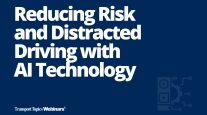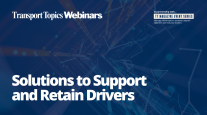Distracted Driving Tops List of NTSB’s Safety Priorities
By Eric Miller, Staff Reporter
This story appears in the Jan. 20 print edition of Transport Topics
WASHINGTON — Eliminating substance-impaired and distracted driving, as well as strengthening vehicle-occupant protection, were included on the National Transportation Safety Board’s Most Wanted List of safety issues released last week.
“Transportation is safer than ever,” NTSB Chairman Deborah Hersman said at a Jan. 16 news conference here. “But still, every year, we have more than 35,000 fatalities in transportation in the United States.”
Hersman said the agency will be pressing for legislation on distracted and impaired driving.
“With impaired and distracted driving, we’re seeing action across the country with very involved legislators and new bills being introduced,” Hersman said. “We know that there are changes that can be made, both at the federal level and state level, to address two of the biggest killers on our highways.”
There are 10 items on the agency’s list, including all transportation modes. The agency regards the issues as those that are “ripe” for legislative or regulatory actions.
“If it was all about the numbers, the only issues on our list would be about highway safety,” said Hersman, noting that 90% of U.S. accident fatalities occur on highways. “But we are the National Transportation Safety Board. We investigate accidents in all modes of transportation, and we have to identify ways to improve safety in each of those modes.”
American Trucking Associations President Bill Graves congratulated NTSB on its commitment to safety.
“We appreciate NTSB’s persistence in addressing critical safety issues, especially those that affect the trucking industry’s workplace, our highways,” Graves said. “ATA has long been a proponent of reducing the risks of distracted driving, eliminating drunk or drugged driving by all motorists and improving the crashworthiness of vehicles. It makes good sense for NTSB to shine a light on these important issues.”
In an interview following the press conference, Hersman said that occupant protection was less of an issue in the trucking industry, since truck drivers use their seat belts more often than those in passenger vehicles.
But she said that, so far, NTSB investigations have not yet yielded evidence of any serious truck design flaws.
“Certainly, we’ve talked to drivers about design issues,” Hersman said. “But our investigations at this point in time have not identified issues there. But I do know that there’s concern in the industry about a lack of standards.”
Other issues on the safety list include drawing attention to the dangers of hazardous weather in aviation, implementing positive train-control systems, promoting operational safety in rail mass transit, passenger ship safety, helicopter operations safety, enhancing pipeline safety and fire safety in transportation.
The NTSB does not have formal rulemaking authority, but its high-profile accident investigations and resultant reports and safety recommendations often carry weight with federal safety regulatory agencies.
Hersman said the agency will be promoting its safety issues through its website, social media outlets and providing testimony in state legislatures and Congress.
Five of the safety areas on this year’s list were carried over from the 2013 list. New issues on the list include helicopter operations safety, occupant protection, ship passenger safety and safety in mass transit.
Hersman said the agency is “sharpening” last year’s focus on the aviation industry’s need to promote hazardous weather awareness.
She added that the agency will be “keeping the pressure on, and we’ll be covering new ground in the coming year” on the repeat issues.



